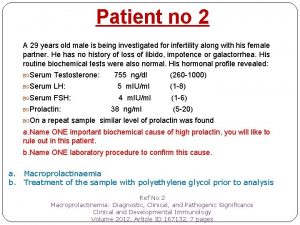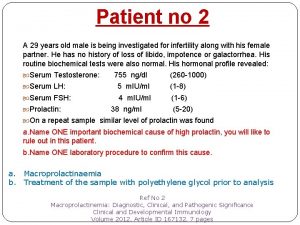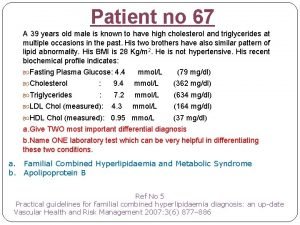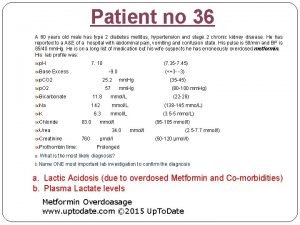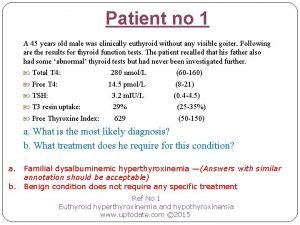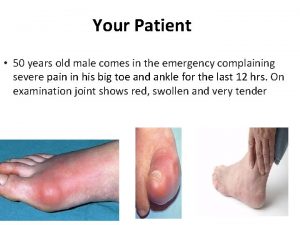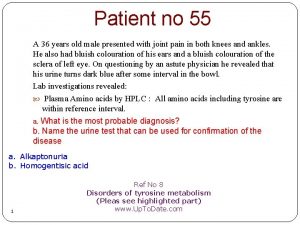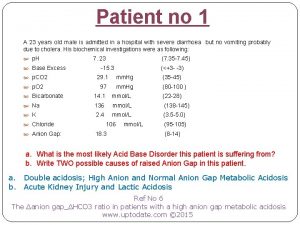Patient no 48 A 7 years old male











- Slides: 11

Patient no 48 A 7 years old male child presented with history of diarrhea, anorexia, abdominal distension and vomiting for the last 3 years. His height and weight are at 5 th and 7 th percentile, respectively. His Lab investigations revealed Blood Hb: 8 g/dl ALT: 40 U/L Urea: 4. 2 mmol/L a. What is the most likely diagnosis? b. Suggest one most important biochemical investigation for confirmation of the diagnosis. a. Coeliac Disease b. Xylose Absorption Test (anti tissue transglutaminase antibody (TTG) may also be accepted to give benefit of doubt about the nature of TTG test i. e. biochemical or not). Ref No 8 Clinical features and diagnosis of malabsorption WWW. Up. To. Date. com

Celiac disease The classic description of celiac disease, or glutensensitive enteropathy, includes the following three features: Symptoms of malabsorption such as steatorrhea, weight loss, or other signs of nutrient or vitamin deficiency. The presence of characteristic histologic changes (including villous atrophy) on small intestinal biopsy. Resolution of the mucosal lesions and symptoms upon withdrawal of gluten-containing foods, usually within a few weeks to months.

Celiac disease Pathogenesis: Genetic factors Autoimmunity: Celiac disease is associated with a number of autoimmune disorders including type 1 diabetes mellitus and autoimmune thyroid disease. In addition, the intestinal lesion of celiac disease is associated with several different autoantibodies that are useful for diagnostic purposes. Ig. A-antibodies against endomysium and the endomysial autoantigen tissue transglutaminase are highly sensitive and specific

Celiac Disease A Chemical Pathologist encounters such children mostly in the Endocrine Clinic referred for growth hormone (GH) evaluation in a short stature child. It is important to rule out this disease clinically and/or anti-body testing before GH testing. Intestinal biopsy and anti-tissue transglutaminase antibodies are characteristic lab tests In celiac disease Xylose Absorption Test is

Patient no 49 A 38 years old male complains of diarrhoea with large volume stools lasting during day and night. His biochemical profile revealed: Stool sodium : 125 mmol/L Stool potassium: 7. 5 mmol/L Stool Osmolality Gap: 27. 5 m. Osm/Kg a. Which type of diarrhoes this patient is suffering from (Secretory or Osmotic) b. Write the formula to calculate the osmotic gap used in this patient. a. Secretary diarrohea b. Stool Osmolality Gap = 290 2 ({Na+} + {K+}) Ref No 2 Approach to the adult with chronic diarrhoea in developed countries www. uptodate. com 2015

Categorization of Diarrhoea Fatty diarrhoea Inflammatory diarrhoea Watery diarrhoea o Secretory o Osmotic

Differentiation of Secretory and osmotic Diarrhoea Secretory and osmotic can be differentiated by stool osmotic gap Please note for calculation of stool osmolality gap a single value (290) is used. Causes of secretory diarrhoea include GI tumours like carcinoid and VIPoma Causes of osmotic diarrhoea include lactose and fructose intolerance Breath test is used to differentiate lactose from fructose intolerance

Patient no 50 a. b. A 31 years old male presented with diarhhoea, abdominal pain and heartburns. His laboratory findings are as following: Haemoglobin: 10. 4 g/d. L Serum Gastrin: 1121 pg/m. L Gastric p. H: 3. 1 What is the most probable diagnosis Name the dynamic (stimulation) test you will like to perform to confirm it a. Zollinger Ellison Syndrom b. Secretin Stimulation Test Ref No 4 Zollinger-Ellison syndrome (gastrinoma): Clinical manifestations and diagnosis (Pleas see highlighted part) www. Up. To. Date. com

Zollinger Ellison Syndrome (ZES) ZES comprises gastrinomas with some clinical manifestations e. g. severe acid peptic disease and diarrhoea. Serum gastrin levels > 1000 pg/ml is diagnostic of the disease but gastric p. H < 4 is essential for the diagnosis of ZES. If gastric p. H > 4 then gastrin level may be as high as 1000 pg/ml in conditions like achlorhydria or PPI treatment Secretin stimulation test is carried out for confirmation of ZES

Patient no 51 A 70 years old man presented in an Accident and Emergency department with symptoms of hot, red flushing of the face; severe diarrhea and asthamatic attacks: Na 141 mmol/L (138 -145) K 4. 4 mmol/L (3. 5 - 5. 0) Chloride 110 mmol/L (95 -105) Bicarbonate 21 mmol/L (23_33) Urine 5 -hydroxyindoleacetic acid (5 -HIAA) : 25 mg/g of creatinine (<16) a. What is the most likely diagnosis? b. Name a test used to confirm this diagnosis in borderline cases? a. Carcinoid syndrome b. Chromogranins and /or Platelet Serotonin Level Ref No 6 Diagnosis of the carcinoid syndrome and tumour localization www. Up. To. Date. com 10

Carcinoid Syndrome • Carcinoid syndrome is constellation of chronic flushing and diarrhoea • Caused by serotonin released form metastatic tumours of the mid-gut (i. e. distal small intestine and proximal colon) • 5 Hydroxyindole acetic acid (5 HIAA) is the principal metabolite detected in 24 h urine. • Other markers include serotonin and chromogranins












